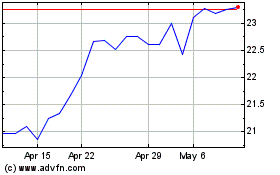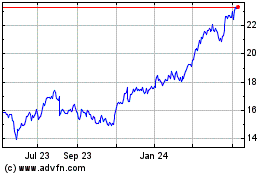Intesa Sanpaolo Sees Benefit From Low Interest Rates
11 February 2016 - 2:00AM
Dow Jones News
The chief executive of Italian lender Intesa Sanpaolo said there
is "a lot of concern" about low and negative interest rates among
European banks, but that the environment has helped Intesa lower
its own cost of funding.
The bank, Italy's second-biggest by assets, said last week its
net interest income—a measure of the profit earned on the
difference between what a bank charges for loans and pays for
deposits—rose slightly in the fourth quarter of last year from the
third quarter.
Carlo Messina, the CEO, said in an interview that Intesa could
see savings of between around €200 million ($226 million) and €300
million a year on the cost of its own borrowing over the medium
term.
Low and negative rates are generally tough for banks, because
they reduce the spread between loans and deposits—typically, banks
have a hard time imposing negative rates on their own depositors.
Intesa said its net interest income for all of 2015 fell 6.5% from
the year before.
Nonetheless, it reported that net income more than doubled in
2015, thanks to higher fee income in its asset-management business
and an improvement in the quality of its loans: It said its total
nonperforming loans fell in the fourth quarter.
European bank shares have been battered this year by a welter of
concerns, among them the pressure induced by near-zero rates. A
European bank-stock index is off nearly a quarter in 2016, even
after a 5% rise in midday trading Wednesday.
Intesa shares were up nearly 13%. It is Italy's largest bank by
market value. Shares of the largest bank by assets, UniCredit SpA,
were up 11%.
In the interview, Mr. Messina said concerns about bad loans and
liquidity in the Italian banking system were overwrought.
Investors have pummeled a regional lender, Banca Monte dei
Paschi di Siena SpA, which has long been troubled by concerns about
its capital position and by bad loans. It is at the center of
worries over how Italy will consolidate and clean up its banking
sector, which is peppered with small and weak regional banks. Monte
dei Paschi has been for sale for more than a year.
Although Intesa's own deposits from its banking business have
risen (up €13 billion in the fourth quarter from the third), Mr.
Messina said he saw no signs of a sustained flight from other
banks. "There is not clear evidence of a problem with liquidity in
the country," he said.
He said Intesa's stock of bad loans had improved thanks in part
to higher household consumption in Italy, which gave firms more
cash and increased their ability to pay.
Italian households are "coming back to consumption," he
said.
Write to Charles Forelle at charles.forelle@wsj.com
(END) Dow Jones Newswires
February 10, 2016 09:45 ET (14:45 GMT)
Copyright (c) 2016 Dow Jones & Company, Inc.
Intesa Sanpaolo (PK) (USOTC:ISNPY)
Historical Stock Chart
From Mar 2024 to Apr 2024

Intesa Sanpaolo (PK) (USOTC:ISNPY)
Historical Stock Chart
From Apr 2023 to Apr 2024
